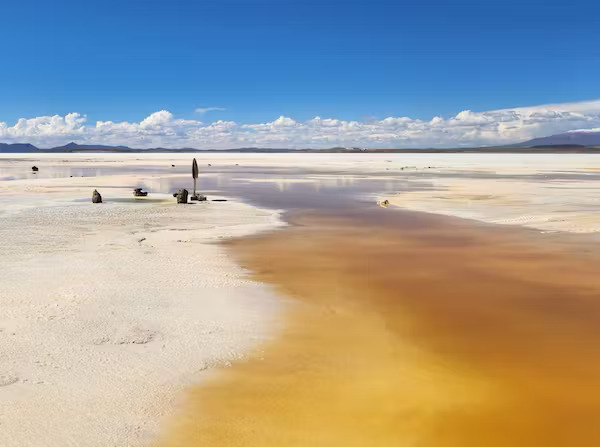Raw Materials or Sacred Beings? Lithium Extraction in Bolivia Puts Two Worldviews into Tension
ENVIRONMENT, 8 May 2023
Mario Orospe Hernández | The Conversation - TRANSCEND Media Service
A rapid escalation of lithium extraction in the Bolivian Andes conflicts with the beliefs of Indigenous communities who call the region home.
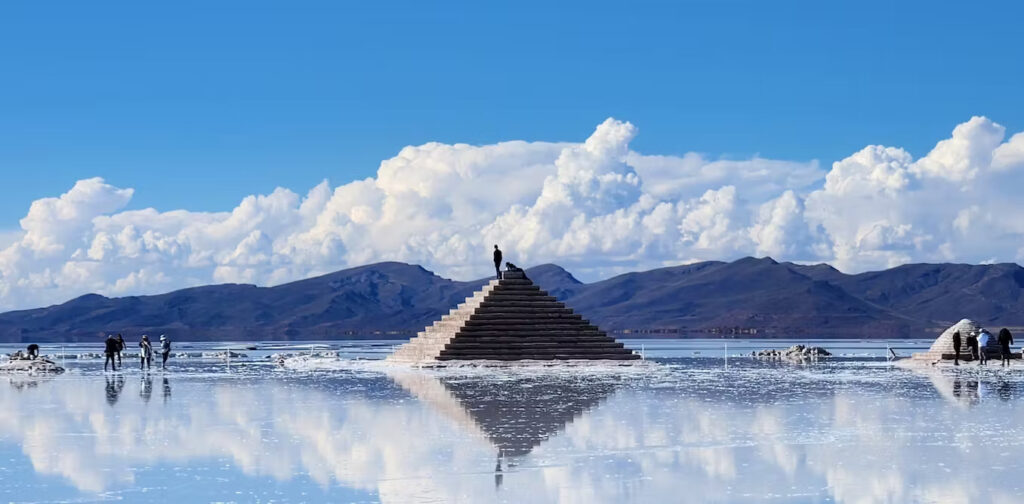
A salt pyramid in Uyuni, Bolivia. The rainy season produces a mirror effect in the salt flat.
Mario Orospe Hernandez, CC BY-NC-ND
28 Apr 2023 – Located in the heart of South America, Bolivia contains the largest lithium deposits in the world – an enviable position, in many countries’ eyes, as the market for electric vehicles takes off.
Though EVs emit fewer greenhouse gases than fuel-powered vehicles, their batteries require more minerals — especially lithium, which is also used to make batteries for smartphones and computers.
Unlike its neighbors Chile and Argentina, Bolivia has yet to become a major player in the global lithium market. In part, this is because its high-altitude salt flats aren’t suited to the usual extraction method, solar evaporation.
Read: Chilean President Plans to Nationalize Lithium Industry
But that looks poised to change in Bolivia: In January 2023, state company YLB signed an agreement with the Chinese consortium CBC, which includes the world’s largest producer of lithium-ion batteries, to introduce a new method called direct lithium extraction.
It may prove an economic boon. But since colonial times, the legacy of mineral abundance in Bolivia has also been one of pollution, poverty and exploitation. While some residents are hopeful about the potential benefits of the growing lithium industry, others are concerned about extraction’s local impact.
In particular, direct lithium extraction demands a great deal of fresh water, potentially endangering surrounding ecosystems as has happened in other parts of South America’s “lithium triangle.”
A rapid escalation of lithium extraction in the Bolivian Andes also represents a looming clash between two fundamentally different views of nature: modern industrial society’s and that of the Indigenous communities who call the region home – a focus of my current research collaborations and dissertation project.
The Pachamama
Bolivia is home to 36 ethnic groups across its highland and lowland regions. Aymara and Quechua peoples comprise most of the Indigenous communities in the Andes Mountains.
For these cultures, nature is not a means to human ends. Instead, it is seen as a group of beings with personhood, history and power beyond human reach. For example, the female divinity of fertility, to whom people owe respect, is the Pachamama.
Since she sustains and secures the reproduction of life, Andean Indigenous people make offerings to the Pachamama in ancestral rituals known as “challas” that seek to reinforce their connection with her.
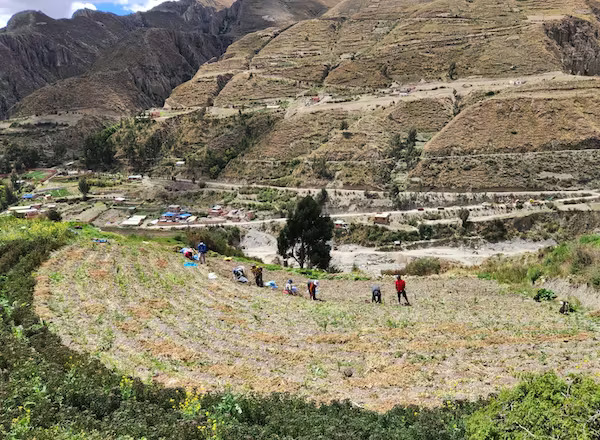
Local food producers in Chicani, a village on the outskirts of La Paz, Bolivia.
(Mario Orospe Hernandez, CC BY-NC-ND)
Similarly, highland groups recognize mountains not as a set of inert rocks, but as ancestral guardians called “Achachilas” in Aymara and “Apus” in Quechua. Each Andean community praises a nearby mountain whom they believe protects and oversees their lives.
In Uyuni, for example, where one of the two new lithium plants will be constructed, Indigenous communities acknowledge the presence of these sacred beings. To this day, worshipers in nearby Lipez region explain the salt flat’s origin with a traditional legend: It is the mother’s milk of their Apu, a female volcano named Tunupa.
However, religious concepts such as “sacred” or “divine” do not necessarily capture the relationships that Andean Indigenous people have long established with these more-than-human beings, who have been known since pre-colonial times as “huacas.” These entities are not considered “gods,” or thought of as dealing with otherworldly beliefs. Rather, they are treated as integral to people’s earthly everyday life.
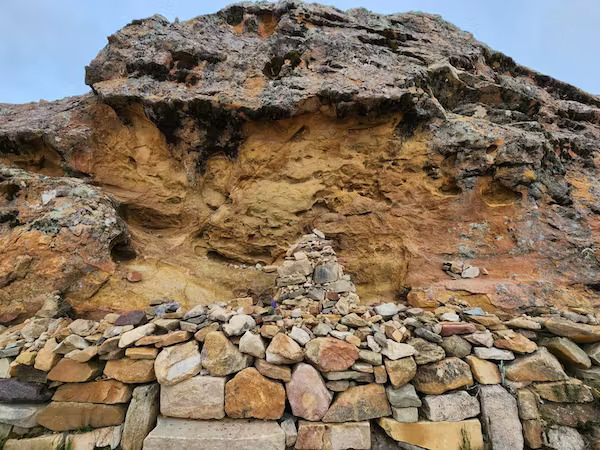
A Quechua huaca, also known as the sanctuary of the sacred rock, on the Island of the Sun in Lake Titicaca. (Mario Orospe Hernandez, CC BY-NC-ND)
For instance, before meals, Quechua and Aymara peoples throw coca leaves or spill their drinks on the ground to share their food with these beings as a sign of gratitude and reciprocity.
Lifeless Matter
In industrial societies, on the other hand, nature is understood as something external to humanity – an object that can be mastered through science and technology. The modern economy turns nature into a source of raw materials: morally and spiritually inert matter that is there to be extracted and mobilized worldwide.
Within this framework, a mineral like lithium is a resource to be developed in the pursuit of economic gains for human beings.
In fact, the history of these competing notions is deeply entwined with the history of the colonial era, as different cultures came into violent conflict. As the Spanish discovered the mineral bounty of the so-called New World, like gold and silver, they began an intensive extraction of its riches, relying on forced labor from local people and imported slaves.
The concept of “raw materials” can be traced to the theological notion of “prime matter.” The term originally comes from Aristotle, whose work was introduced to Christianity via Latin translations around the 12th century.
In the way Christians adapted his idea of prime matter, everything was ordered by its level of “perfection,” ranging from the lowest level – prime matter, the most basic “stuff” of the world – to rocks, plants, animals, humans, angels and, finally, God.
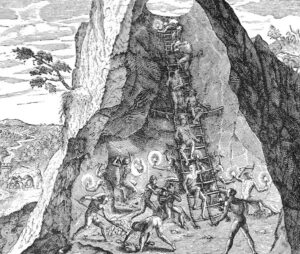
A silver mine at Potosi, New Spain – now Bolivia – depicted by Theodor de Bry around 1590.
(ullstein bild/ullstein bild via Getty Images)
The Catholic Church and the Spanish Empire later used this medieval understanding of matter as something passive, without spirit, to justify the extraction of resources during colonial times. The closer things were to prime matter, their argument supposed, the more they needed human imprint and an external purpose to make them valuable.
This notion was also used by Christian colonizers who were intent on destroying traditions that they saw as idolatrous. In their eyes, reverence toward a mountain or the earth itself was worshiping a mere “thing,” a false god. The church and the empire believed it was critical to desacralize these more-than-human beings and treat them as mere resources.
This flattened vision of nature served as the basis for the modern economic concept of raw materials, which was introduced in the 18th century with the birth of economics as a social science.
The Road Ahead
Bolivia’s lithium projects pose a new potential clash of worldviews.
However, extraction initiatives have faced severe setbacks in the last few years, including social protests, the 2019 political crisis and a lack of necessary technology. The Chinese deal represents a new milestone, yet its outcomes are still uncertain: for the economy, for local communities and for the Earth.
Today, electric vehicles are widely considered part of the solution to the climate crisis. Yet they will necessitate a mining surge to meet their battery demands.
If societies really want a greener future, technological shifts such as EVs will be just part of the answer, alongside other changes like more sustainable urban planning and improved public transportation.
But in addition, perhaps other cultures could learn from Andean relations with nature as more-than-human beings: an inspiration to rethink development and turn our own way of living into something less destructive.
___________________________________________
Mario Orospe Hernández is a Ph.D. candidate in religious studies at Arizona State University.
Go to Original – theconversation.com
Tags: Bolivia, Capitalism, Conflict, Ecology, Environment, Extractivism, Indigenous Culture, Indigenous Rights, International Trade, Latin America Caribbean, Lithium, Resources, Social conflict
DISCLAIMER: The statements, views and opinions expressed in pieces republished here are solely those of the authors and do not necessarily represent those of TMS. In accordance with title 17 U.S.C. section 107, this material is distributed without profit to those who have expressed a prior interest in receiving the included information for research and educational purposes. TMS has no affiliation whatsoever with the originator of this article nor is TMS endorsed or sponsored by the originator. “GO TO ORIGINAL” links are provided as a convenience to our readers and allow for verification of authenticity. However, as originating pages are often updated by their originating host sites, the versions posted may not match the versions our readers view when clicking the “GO TO ORIGINAL” links. This site contains copyrighted material the use of which has not always been specifically authorized by the copyright owner. We are making such material available in our efforts to advance understanding of environmental, political, human rights, economic, democracy, scientific, and social justice issues, etc. We believe this constitutes a ‘fair use’ of any such copyrighted material as provided for in section 107 of the US Copyright Law. In accordance with Title 17 U.S.C. Section 107, the material on this site is distributed without profit to those who have expressed a prior interest in receiving the included information for research and educational purposes. For more information go to: http://www.law.cornell.edu/uscode/17/107.shtml. If you wish to use copyrighted material from this site for purposes of your own that go beyond ‘fair use’, you must obtain permission from the copyright owner.
